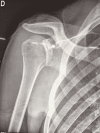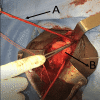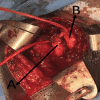Complex Posterior Glenohumeral Instability Case Management
- PMID: 35602811
- PMCID: PMC9117827
- DOI: 10.7759/cureus.24198
Complex Posterior Glenohumeral Instability Case Management
Abstract
A 21-year-old male patient suffering from insidious shoulder instability from neurogenic and structural attenuation of shoulder stabilizer, due to old minor cerebrovascular accident, presented with a two-year history of repetitive shoulder dislocation, operated by fixing the biceps tendon to its insertion on the superior labrum, correction of the glenoid version and reattaching the subscapular tendon along with a new technique for stabilization of the shoulder replicating the coracohumeral ligament with a ligament advanced reinforcement system (LARS) transplant. Following structured physical therapy, our patient returned to normal daily activities at 15 months.
Keywords: coracohumeral ligament; glenohumeral joint; labrum; posterior shoulder instability; surgical technique.
Copyright © 2022, Melhem et al.
Conflict of interest statement
The authors have declared that no competing interests exist.
Figures








Similar articles
-
Anatomy and function of the glenohumeral ligaments in anterior shoulder instability.Clin Orthop Relat Res. 2002 Jul;(400):32-9. doi: 10.1097/00003086-200207000-00005. Clin Orthop Relat Res. 2002. PMID: 12072743 Review.
-
Quantitative and Qualitative Analyses of the Glenohumeral Ligaments: An Anatomic Study.Am J Sports Med. 2020 Jul;48(8):1837-1845. doi: 10.1177/0363546520917665. Epub 2020 May 22. Am J Sports Med. 2020. PMID: 32441993
-
Arthroscopic management of posterior instability: evolution of technique and results.Arthroscopy. 2008 Apr;24(4):389-96. doi: 10.1016/j.arthro.2007.11.004. Arthroscopy. 2008. PMID: 18375269
-
Functional anatomy of the superior glenohumeral and coracohumeral ligaments and the subscapularis tendon in view of stabilization of the long head of the biceps tendon.J Shoulder Elbow Surg. 2010 Jan;19(1):58-64. doi: 10.1016/j.jse.2009.04.001. J Shoulder Elbow Surg. 2010. PMID: 19535271
-
Anatomical basics, variations, and degenerative changes of the shoulder joint and shoulder girdle.Eur J Radiol. 2000 Aug;35(2):88-102. doi: 10.1016/s0720-048x(00)00225-4. Eur J Radiol. 2000. PMID: 10963915 Review.
References
-
- Rehabilitation for shoulder instability. Jaggi A, Lambert S. Br J Sports Med. 2010;44:333–340. - PubMed
-
- Posterior-inferior capsular shift for the treatment of recurrent, voluntary posterior subluxation of the shoulder. Fuchs B, Jost B, Gerber C. J Bone Joint Surg Am. 2000;82:16–25. - PubMed
-
- Thoracohumeral muscle activity alters glenohumeral joint biomechanics during active abduction. Konrad GG, Jolly JT, Labriola JE, McMahon PJ, Debski RE. J Orthop Res. 2006;24:748–756. - PubMed
-
- Muscle activity and coordination in the normal shoulder. An electromyographic study. Kronberg M, Nemeth G, Brostrom LA. https://europepmc.org/article/med/2379377 Clin Orthop Relat Res. 1990;257:76–85. - PubMed
Publication types
LinkOut - more resources
Full Text Sources
